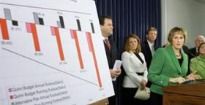States Facing $1.26T Pension Shortfall
The state funds that pay pension and health-care benefits to retired teachers, corrections officers and millions of other public workers faced a cumulative shortfall of at least $1.26 trillion at the end of fiscal 2009, according to a new report.
The study, to be released Tuesday by the Pew Center on the States, found that the pension and health-care funding gap increased by 26 percent over the previous year. Pew officials said the growing shortfall was driven by inadequate state contributions, an aging population and market losses that accompanied the recession.
Although investment markets have recovered substantially since the period covered by the report, its authors warn that states still face an increasing burden from retiree costs that are beginning to crowd out critical services.
“In many states, the bill for public-sector retirement benefits already threatens strained budgets and is competing for resources with other critical needs, including education, infrastructure and health care,” said Susan Urahn, managing director of the Pew Center on the States.
The report, which is based on state financial reports, found that states faced a $660 billion pension funding gap. Meanwhile, retiree health-care liabilities — which most states handle on a pay-as-you-go basis — totaled $604 billion, the report said.
Even as they face increasing liabilities, the report said, many states are not making pension contributions in amounts recommended by their actuaries as they juggle retiree and other costs against a backdrop of weak revenue.
In making its calculations, Pew used the states’ assumptions for what their pension funds would earn in annual investment returns, typically 8 percent — a figure that states have mostly met in recent decades but that some analysts think is now overly optimistic.
If states calculated their investment returns the same way that private firms are required to for their pensions, their obligations would balloon to $1.8 trillion, the report said. If states pegged their returns to 30-year Treasury bonds, an even more conservative standard, the liability would be $2.4 trillion.
Concern about underfunded pensions has prompted at least 29 states to either reduce pension promises to new employees or require workers to contribute more toward their retirement benefits, according to a separate report by Pew.
Three states — South Dakota, Minnesota and Colorado — have moved to reduce cost-of-living increases for current retirees, but those moves are facing court challenges.
Click here to read more.


